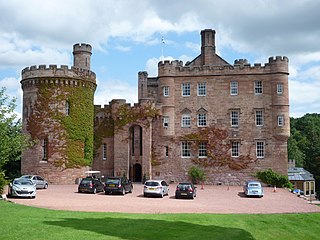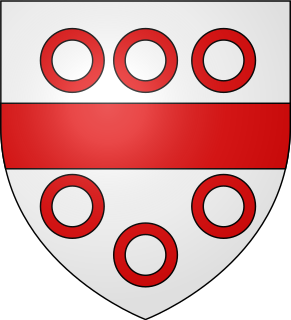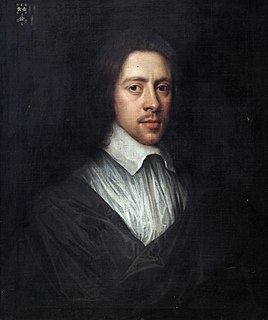Barons Darcy and Conyers (1641)

- Conyers Darcy, 1st Baron Darcy and Conyers (d. 1654)
- Conyers Darcy, 2nd Baron Darcy and Conyers (created Earl of Holderness in 1682), see below.
The title Earl of Holderness also known as Holdernesse existed in the late 11th and early 12th centuries as a feudal lordship and was officially created three times in the Peerage of England namely in 1621, in 1644 as a subsidiary title to that of the then-Duke of Cumberland and in 1682. The official creations lasted 5, 38 and 96 years respectively.
The title was first held by Odo, Count of Champagne created Earl of Holderness (an area of land occupying the far east of East Yorkshire along the North Sea and Humber Estuary) by his brother-in-law William the Conqueror after the Norman Conquest. Odo was stripped of his English lands after being implicated in a plot to put his own son Stephen of Aumale upon the throne of England in place of his first cousin, William II. However, the title was restored to Stephen in 1089. [1]
The first official creation, in 1621, along with the subsidiary title Baron Kingston upon Thames, of Kingston upon Thames in the County of Surrey, was in favour of John Ramsay, 1st Viscount of Haddington. As well as the Barony created with the Earldom, this Earl held the subsidiary titles Viscount of Haddington (1606), Lord Ramsay of Barns (1606) and Lord Ramsay of Melrose (1615), all in the Peerage of Scotland. [1]
The second creation, in 1644, was as a subsidiary title of the Dukedom of Cumberland conferred on Prince Rupert of the Rhine, a nephew of King Charles I. [1]
The third creation, in 1682, was in favour of Conyers Darcy, 2nd Baron Darcy and Conyers. In 1641, his father, Sir Conyers Darcy, had successfully petitioned King Charles I to be restored to the abeyant baronies of Darcy de Knayth (created 1332) and Conyers (created 1509), with remainder to his heirs male. [2] These were considered new creations that became extinct upon the death of the 4th Earl of Holderness, at which time the earldom also became extinct. (The 1641 decision was reversed in 1903, however, and both baronies were restored to the original remainders, which could be inherited by daughters.) [3]


Earl of the County of Cork, usually shortened to Earl of Cork, is a title in the Peerage of Ireland, held in conjunction with the Earldom of Orrery since 1753. It was created in 1620 for the Anglo-Irish politician Richard Boyle, 1st Baron Boyle. He had already been created Lord Boyle, Baron of Youghal, in the County of Cork, in 1616, and was made Viscount of Dungarvan, in the County of Waterford, at the same time he was given the earldom. These titles are also in the Peerage of Ireland.

The title Duke of Abercorn is a title in the Peerage of Ireland. It was created in 1868 and bestowed upon James Hamilton, 2nd Marquess of Abercorn. Although the Dukedom is in the Peerage of Ireland, it refers to Abercorn, West Lothian, and the Duke also bears four titles in Peerage of Scotland and two in the Peerage of Great Britain, and is one of only three peers who have titles in those three peerages. The Duke of Abercorn also claims the French title of Duke of Châtellerault, created in 1548.

Marquess of Lothian is a title in the Peerage of Scotland. It was created in 1701 for Robert Kerr, 4th Earl of Lothian. The Marquess of Lothian holds the subsidiary titles of Earl of Lothian, Earl of Lothian, Earl of Ancram (1633), Earl of Ancram, Viscount of Briene (1701), Lord Newbattle (1591), Lord Jedburgh (1622), Lord Kerr of Newbattle (1631), Lord Kerr of Nisbet, Langnewtoun, and Dolphinstoun (1633), Lord Kerr of Newbattle, Oxnam, Jedburgh, Dolphinstoun and Nisbet (1701), and Baron Ker, of Kersheugh in the County of Roxburgh (1821), all but the last in the Peerage of Scotland. As The Lord Ker in the Peerage of the United Kingdom, previous Marquesses sat in the House of Lords before 1963, when Scottish peers first sat in the House of Lords in their own right. The holder of the title is also the Chief of Clan Kerr.

Earl of Abingdon is a title in the Peerage of England. It was created on 30 November 1682 for James Bertie, 5th Baron Norreys of Rycote. He was the eldest son of Montagu Bertie, 2nd Earl of Lindsey by his second marriage to Bridget, 4th Baroness Norreys de Rycote, and the younger half-brother of Robert Bertie, 3rd Earl of Lindsey. His mother's family descended from Sir Henry Norris, who represented Berkshire and Oxfordshire in the House of Commons and served as Ambassador to France. In 1572 he was summoned by writ to Parliament as Lord Norreys de Rycote. He was succeeded by his grandson, the second Baron. In 1621 he was created Viscount Thame and Earl of Berkshire in the Peerage of England. He had no sons and on his death in 1624 the viscountcy and earldom became extinct. He was succeeded in the barony by his daughter Elizabeth, the third holder of the title. On her death the title passed to her daughter, the aforementioned Bridget, the fourth Baroness, second wife of the second Earl of Lindsey.

Marquess Townshend is a title in the Peerage of Great Britain held by the Townshend family of Raynham Hall in Norfolk. This family descends from Roger Townshend, who in 1617 was created a baronet, of Raynham in the County of Norfolk, in the Baronetage of England. He later represented Orford and Norfolk in the House of Commons. His younger son, the third Baronet, played an important role in the restoration of the monarchy after the Civil War and was also Member of Parliament for Norfolk. In 1661 he was created Baron Townshend, of Lynn Regis in the County of Norfolk, and in 1682 he was further honoured when he was made Viscount Townshend, of Raynham in the County of Norfolk. Both titles were in the Peerage of England.

Earl of Dalhousie, in the County of Midlothian, is a title in the Peerage of Scotland, held by the Chief of Clan Ramsay.

Baron Lucas is a title that has been created twice in the Peerage of England. The second creation is extant and is currently held with the title Lord Dingwall in the Peerage of Scotland.
Baron Darcy de Knayth is a title in the Peerage of England. It was created in 1332 for John Darcy with remainder to his heirs general, allowing daughters to inherit.

Earl of Powis (Powys) is a title that has been created three times. The first creation came in the Peerage of England in 1674 in favour of William Herbert, 3rd Baron Powis, a descendant of William Herbert, 1st Earl of Pembroke. In 1687, he was further honoured when he was made Marquess of Powis.

Earl of Plymouth is a title that has been created three times: twice in the Peerage of England and once in the Peerage of the United Kingdom.
The County of Aumale, later elevated to a duchy, was a medieval fief in Normandy. It was disputed between England and France during parts of the Hundred Years' War.
Earl Rivers was an English title, which has been created three times in the Peerage of England. It was held in succession by the families of Woodville, Darcy and Savage.
Baron Fauconberg is an hereditary title created twice in the Peerage of England.

Baron Conyers is a title in the Peerage of England. It was created on 17 October 1509 for William Conyers, the son-in-law of William Neville, 1st Earl of Kent. The abeyance after the death of the 3rd baron was terminated for the 7th Baron Darcy de Knayth, these baronies were held together until the abeyance of 1888, after which the abeyance of these two baronies were separately terminated. Since 1509, the Barons Conyers had held a part of the "right" to the barony Fauconberg, i.e. the part for which the abeyance was terminated in 1903; and since the termination of the abeyance of the barony Fauconberg, the two baronies, Conyers and Fauconberg, had been held together; from 1948 they were abeyant between the two daughters of the 5th Earl of Yarborough. On the death of the younger daughter in 2012 the abeyance terminated automatically in favour of her elder sister, the 15th holder of the title. Since the death of the latter in 2013, the title is in abeyance once more.

Baron Clifford is a title in the Peerage of England created by writ of summons on 17 February 1628 for Henry Clifford . Henry, Lord Clifford inherited his father's title in 1641, whereupon he sat in the House of Lords as Earl of Cumberland until his death in 1643.

Baron Wentworth is a title in the Peerage of England. It was created in 1529 for Thomas Wentworth, who was also de jure sixth Baron le Despencer of the 1387 creation. The title was created by writ, which means that it can descend via female lines.
Baron Darcy of Chiche was a title in the Peerage of England.
John Ramsay, 1st Earl of Holderness, known as Sir John Ramsay between 1600 and 1606, and as the Viscount of Haddington between 1606 and 1621, was an important Scottish aristocrat of the Jacobean era, best known in history as the first favourite of James I when he became king of England as well as Scotland in 1603.

Conyers Darcy, 2nd Earl of Holderness was an English politician who sat in the House of Commons from 1660 to 1679 and later became a peer.

Conyers Darcy, 1st Earl of Holderness was a British noble; created Earl of Holderness in 1682.